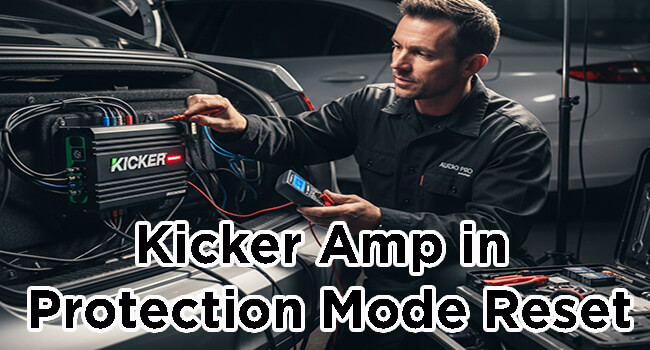8 Effective Way to Fixes: Kicker Amp in Protection Mode Reset
Your music suddenly stops playing. You see a steady red light. Your Kicker amp is in protection mode. This is a built-in safety feature. It protects the amp from damage. I am a technician with experience. I see this problem very often. The amp senses a serious issue. It shuts itself down to survive. Do not worry about this situation. We will diagnose the problem together. I will guide you through each step. We will find the cause and fix it. Your system will be running again.

Protection mode means something is wrong. It could be a number of things. The cause could be very simple. Or it might be more complex. We need a systematic approach now. We do not want to guess. Guessing can cause even more damage. Following my steps ensures a safe fix. We will work like professionals do. Let’s get your powerful Kicker amp back. It will be making music very soon.
# Table of Contents =>
- 1 How to Get Kicker Amp Out of Protection Mode: 8 Quick Reset Tips
- 1.1 Step 1: The Basic Reset Procedure
- 1.2 Step 2: Checking for Overheating
- 1.3 Step 3: Inspecting Power and Ground Wires
- 1.4 Step 4: Using a Digital Multimeter
- 1.5 Step 5: Checking the Remote Turn-On Wire
- 1.6 Step 6: Isolating the Speaker Outputs
- 1.7 Step 7: Inspecting Speaker Wires and Speakers
- 1.8 Step 8: Need Professional Help
- 1.9 Conclusion: A Patient and Methodical Approach
The Red Protection Light –
That red light is your best friend. It tells you there is a problem. It prevents a catastrophic amplifier failure. The amp’s internal circuits are very sensitive. They monitor voltage, current, and temperature. Any reading outside the safe range triggers it. The amp essentially sacrifices its operation. It does this to protect itself. Think of it as a circuit breaker. It trips to prevent an electrical fire. Your Kicker amp does the same thing. It is a very smart design feature.
Many things can trigger this mode. Overheating is a very common cause. Low input voltage is another culprit. A bad ground connection causes many issues. Speaker problems are also a frequent source. This includes shorted or blown speakers. An improper impedance load is another reason. We must check all of these possibilities. We will start with the easiest fixes. Then we move to more detailed checks.
How to Get Kicker Amp Out of Protection Mode: 8 Quick Reset Tips
Step 1: The Basic Reset Procedure
Sometimes the solution is very easy. An amp can have a temporary glitch. A simple power cycle can fix this. Let’s try this easy method first. This process resets the internal circuits. It gives the amp a fresh start.
First, you need to turn your vehicle off. Remove the key from the ignition. This ensures all power is cut. Now, locate your amplifier’s main fuse. This fuse is near the battery. It is on the thick red power wire. Carefully pull this main fuse out. Wait for at least five full minutes. This allows all capacitors to discharge. The amp’s memory will fully reset.
After waiting, reinsert the fuse securely. Make sure it has a solid connection. Now, you can start your vehicle. Turn on your stereo at low volume. Does the amplifier turn on normally? Does a green or blue light show? If so, your problem may be solved. This simple reset sometimes works wonders. If the red light returns, we dig deeper.
Step 2: Checking for Overheating
Amplifiers generate a significant amount of heat. They need proper airflow to stay cool. Overheating is a primary protection trigger. Your Kicker amp has a thermal sensor. It shuts the amp down if it’s too hot. This prevents internal components from melting.
Feel the amplifier’s heatsink with your hand. Is it extremely hot to the touch? If it is, we have found our issue. Turn the entire system off immediately. Let the amplifier cool down completely. This can take thirty minutes or more. While it cools, inspect its location.
Is the amp mounted under a seat? Is it covered with carpets or luggage? Amplifiers need space to breathe properly. Ensure there is clearance around the amp. At least three inches on all sides. Do not mount amps in enclosed spaces. Good airflow is absolutely critical for performance. Also, check that the amp’s cooling fans work. If it has fans, they should spin.
Step 3: Inspecting Power and Ground Wires
The most common issues are electrical. A solid electrical foundation is everything. Your amp needs clean, stable power. A poor connection causes voltage drops. This will trigger the protection mode. I always check these wires first.
a) Examining the Main Power Wire
Start with the thick red power wire. It runs from the battery to the amp. Check the entire length for damage. Look for any cuts, burns, or kinks. Ensure the fuse holder is not melted. The fuse itself should be the correct rating. Never use a higher amperage fuse. Make sure all connections are tight. Check the connection at the battery terminal. Check the connection at the amp’s terminal. A loose wire here is very bad.
b) Verifying the Ground Connection
The ground wire is the most important wire. I cannot stress this point enough. A bad ground causes countless problems. It should be a short, thick wire. It must connect to the car’s chassis. The connection point needs to be perfect. Find where the ground wire is attached.
Disconnect the ground wire from the chassis. Sand the contact point to bare metal. You must remove all paint and rust. This ensures a clean metal-to-metal bond. Use a star washer for a better grip. Reattach the ground wire very tightly. A weak ground is a common failure point. It creates resistance and voltage issues. This will surely trigger protection mode.
Step 4: Using a Digital Multimeter
Now we get a little more technical. A digital multimeter (DMM) is essential. It is the best tool for this job. We will measure voltage accurately. Set your multimeter to DC volts.
First, test the battery voltage itself. Place the red probe on the positive terminal. Place the black probe on the negative. You should see around 12.6 volts. This is with the car turned off. Now, start the car’s engine. The voltage should rise to 13-14.4 volts. This tells us the alternator is working.
Next, we check voltage at the amp. Place the red probe on the amp’s +12V terminal. Place the black probe on the amp’s ground terminal. With the car off, it should be 12.6V. With the car running, it should be 13-14.4V. If the voltage is low here, you have a wiring problem. This is called a voltage drop. Re-check all your power and ground connections.
Step 5: Checking the Remote Turn-On Wire
The amplifier needs a signal to turn on. This comes from the blue remote wire. This wire connects to your head unit. It tells the amp when to power up. A faulty signal can confuse the amp.
Set your multimeter to DC volts again. Turn on your stereo system. Touch the red probe to the remote terminal. Touch the black probe to the ground terminal. You should read at least 12 volts. If the voltage is low or absent, the amp won’t turn on correctly. Check the remote wire’s connection. Ensure it is secure at the head unit. Look for any damage along its path.
Step 6: Isolating the Speaker Outputs
A problem with speakers can trigger protection. This includes the speaker wires themselves. A single strand of wire can cause a short. This will immediately send the amp into protect. We need to isolate the amp now.
Turn off the entire audio system. Disconnect all speaker wires from the amplifier. Make sure no stray strands are touching. The positive and negative terminals must not touch. The terminals must not touch the chassis. Now, turn the system back on. Does the amp power up normally? Is the protection light now off?
If the amp stays on, the problem is downstream. The issue lies in your speaker wires. Or it lies with one of your speakers. This is a very important diagnostic step. It narrows down the potential causes. If the amp is still in protect mode, the issue may be internal to the amp.
Step 7: Inspecting Speaker Wires and Speakers
If the amp works with speakers disconnected, we check them. Inspect each speaker wire run carefully. Look for any pinched or frayed sections. A wire could be shorting to the metal chassis. This happens often in door jambs. Check behind the head unit as well.
Next, we test the speakers themselves. You can use your multimeter for this. Set it to measure resistance, or ohms (). Disconnect the wires from a speaker. Touch the multimeter probes to the speaker terminals. You should get a reading. For a 4-ohm speaker, you might see 3-4 ohms. For a 2-ohm speaker, you might see 1-2 ohms.
If you read 0 ohms, the speaker has a short. If you read infinite ohms, it’s blown open. In either case, that speaker is bad. It must be replaced immediately. Test every single speaker in your system. A single bad speaker will ruin it. Also, check the amplifier’s impedance rating. Make sure your speakers match it. Wiring speakers below the stable ohm load will cause protection mode.
Step 8: Need Professional Help
We have covered many troubleshooting steps. You can solve most problems this way. However, sometimes the issue is more serious. The amplifier itself may have failed. Internal components can burn out over time. This can happen from prolonged abuse.
If you have tried all these steps, there is a chance the amp is faulty. If the amp is in protect mode with nothing connected, it is likely internal failure. Do not attempt to open the amplifier. There are high voltages inside. You can cause more damage or get hurt. This is the time to seek help. Take the amplifier to a qualified technician. They have the tools to test components. They can safely repair the amplifier.
Conclusion: A Patient and Methodical Approach
Fixing an amp in protection mode is a process. It requires patience and methodical work. Do not get frustrated with the red light. It is only trying to help you. It is your system’s early warning sign. By following these steps, you act like a technician. You start with the simplest causes. You work your way to the complex ones.
Always double-check your work carefully. A solid installation is key to prevention. Use the correct gauge wires for power. Ensure a perfect ground connection. Give your amplifier plenty of ventilation. Set your gains correctly with a multimeter. Do not push your system beyond its limits. A well-cared-for Kicker amp provides years of enjoyment. Now you have the knowledge to solve this. You can get back to the music. Enjoy the powerful sound you love.
Last Updated on October 5, 2025 by Perry Garner


